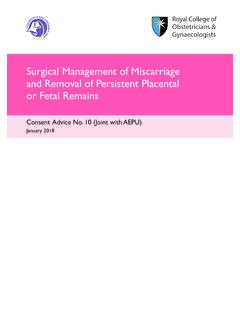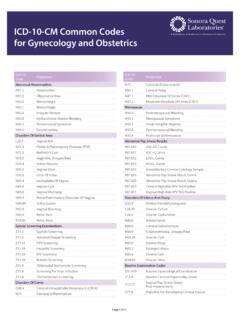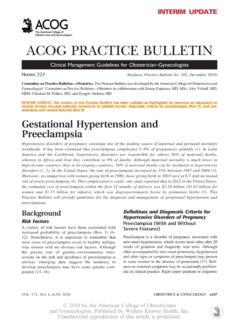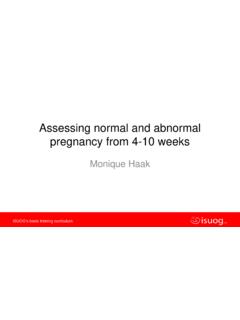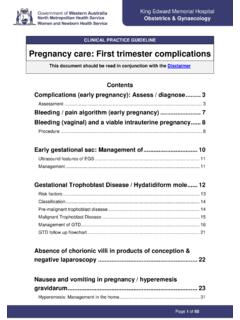Transcription of CLINICAL PRACTICE GUIDELINE HYPEREMESIS AND …
1 CLINICAL PRACTICE GUIDELINE HYPEREMESIS AND NAUSEA/VOMITING IN pregnancy Institute of Obstetricians and Gynaecologists, Royal College of Physicians of Ireland and the CLINICAL Strategy and Programmes Division, Health Service Executive Version Publication date: Nov 2015 GUIDELINE No: 12 Revision date: Nov 2018 CLINICAL PRACTICE GUIDELINE NVP 2 Contents 1. Revision History .. 3 2. Key Recommendations .. 3 3. Purpose and Scope .. 4 4. Background and Introduction .. 4 5. Methodology .. 5 6. CLINICAL GUIDELINE .. 5 7. References.
2 18 8. Implementation Strategy .. 22 9. Qualifying Statement .. 22 10. Appendices .. 23 CLINICAL PRACTICE GUIDELINE NVP 3 1. Revision History Version No. Date Modified By Description 2. Key Recommendations HYPEREMESIS gravidarum, a severe form of nausea and persistent vomiting in pregnancy , must be diagnosed and treated appropriately to reduce associated morbidities and mortality. Diagnosis of HYPEREMESIS gravidarum is by exclusion. Women who experience nausea and vomiting for the first time after 10 weeks gestation are more likely to have an alternative diagnosis to nausea/vomiting in pregnancy .
3 Be aware of potential alternative diagnoses. There should be a low threshold for admission for women with diabetes, hyper/ hypothyroidism, epilepsy or other pre-existing conditions that may be adversely affected by nausea and vomiting. Women with diabetes should be monitored carefully as dehydration increases the risk of diabetic ketoacidosis. The severity of the condition should be assessed using the Modified 24-hour PUQE ( pregnancy Unique Quantification of Emesis and Nausea) score. A clear and concise plan of care should be documented. Using the Modified 24-hour PUQE score and the NVP assessment algorithm, the management plan for individual patients will be outlined.
4 Treatment includes the correction of hypovolemia, electrolyte imbalances and ketosis and the provision of vitamin supplementation, anti-emetic medication and thromboprophylaxis. Consultation with a Dietitian is recommended. There is no evidence to support the effectiveness of dietary restrictions to relieve symptoms and patients are advised to avoid personal triggers of nausea. Psychological support should also be offered to affected women with emphasis placed on the self-limiting nature of the condition. There are a number of Practical Tips included as an Appendix to the GUIDELINE which can be given to women to help them cope with NVP.
5 CLINICAL PRACTICE GUIDELINE NVP 4 3. Purpose and Scope This GUIDELINE is developed to assist the multidisciplinary team in the provision of best PRACTICE care for women with HYPEREMESIS gravidarum or Nausea/Vomiting in pregnancy . These guidelines are intended for healthcare professionals, particularly those in training, who are working in HSE-funded obstetric and gynaecological services. They are designed to guide CLINICAL judgment but not replace it. In individual cases a healthcare professional may, after careful consideration, decide not to follow a GUIDELINE if it is deemed to be in the best interests of the woman.
6 The Aim of Management Assess severity of the condition Correct hypovolemia, electrolyte imbalance and ketosis Provide symptomatic relief to break the cycle of vomiting and prevent further vomiting Provide vitamin supplementation Provide psychological support 4. Background and Introduction Severe vomiting requiring hospitalisation occurs in less than 1% of all pregnant women (Jarvis 2011). Symptoms manifest between 4-7 weeks gestation, the peak severity for HYPEREMESIS is around 11 weeks with 90% of cases resolved by 20 weeks gestation (NICE 2013; Bottomley 2009). The cause of nausea and vomiting in pregnancy is unknown, but may be due to the rise in human chorionic gonadotrophin concentration (Festin 2009).
7 Excessive vomiting of both solid food and liquids may lead to dehydration, ketosis, electrolyte imbalance, thyrotoxicosis and rarely vitamin deficiency in pregnancy (Kuscu 2002). Therapeutic interventions are mainly supportive, in conjunction with anti-emetic medication. Consultation with a dietitian is recommended to obtain an accurate dietary history, advise the woman on coping strategies to optimise nutrient intake, minimise weight loss and recommend nutrition support when necessary. There is no evidence to support the effectiveness of dietary restrictions to relieve symptoms, therefore women should be encouraged to eat small frequent meals of whatever foods appeal to them (Matthews 2014).
8 Women should be offered advice about the self-limiting nature of the condition and advised to avoid personal triggers of nausea. Women with diabetes should be monitored carefully as dehydration increases the risk of diabetic ketoacidosis. CLINICAL PRACTICE GUIDELINE NVP 5 5. Methodology A search of PubMed from 1966 to January 2015 was carried out. Relevant MeSH terms for pregnancy and keywords, including "nausea and vomiting in pregnancy ", " HYPEREMESIS ", and relevant medication names were used. This GUIDELINE was initially developed by Fiona Dunlevy, Frances Richardson and Brian Cleary.
9 The updated GUIDELINE was developed by Laura Harrington, Paula Byrne, Mary O Reilly and Brian Cleary. The GUIDELINE was reviewed by Dr Carmen Regan (CWIUH), Prof John Morrison (Galway), Dr Maire Milner (Drogheda), Dr Meabh Ni Bhuinneain (Mayo), Dr Orla Sheil (NMH), Dr Sharon Cooley (Rotunda), Dr Keelin O Donoghue (Cork), Dr Sam Coulter Smith (Rotunda), Dr Joe Quigley (Drogheda), Dr Brigette Byrne (CWIUH), Prof Louise Kenny (Cork), Triona O Sullivan, (Cork), Ms Mary Doyle (Limerick), Dr Michael Brassil (Portiuncula), Dr Miriam Doyle (Portlaoise), Dr Niamh Hayes (Rotunda), Dr Jennifer Donnelly (Rotunda), Dr Ann McHugh (TCD). 6. CLINICAL guidelines on HYPEREMESIS and Nausea/Vomiting in pregnancy Nausea and vomiting are common in pregnancy , affecting 70% of women in the first trimester (NICE 2013).
10 HYPEREMESIS gravidarum is a severe form of nausea and persistent vomiting in pregnancy which occurs in 1% of all pregnancies (Jarvis 2011; Jewell 2003).Care must be planned to meet the individual needs of the women concerned. HYPEREMESIS is associated with: Weight Loss Ketonuria Electrolyte imbalance and dehydration Vitamin and mineral deficiencies Thyroid/renal/hepatic dysfunction Diagnosis of HYPEREMESIS Gravidarum Diagnosis is by exclusion. A thorough CLINICAL assessment should be carried out. Women who experience nausea and vomiting for the first time after 10 weeks gestation are more likely to have an alternative diagnosis to NVP (Ebrahimi 2010). Be Aware of Potential Differential Diagnoses or Pre-disposing Conditions Urinary tract infection CLINICAL PRACTICE GUIDELINE NVP 6 Multiple pregnancy Gastrointestinal (for example, infection including Helicobacter pylori, reflux oesophagitis, gastritis, cholecystitis, peptic ulceration, hepatitis, appendicitis, pancreatitis, complications after bariatric surgery) Neurological (for example, migraine, raised Intracranial pressure, central nervous system diseases)
